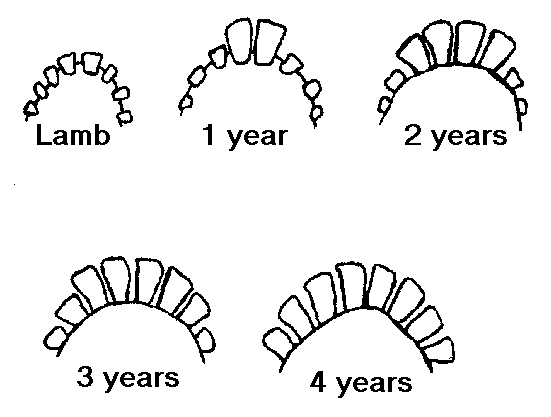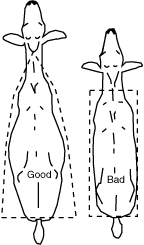
Evaluating meat goat breeding stock
Health
The general appearance of the goat will offer some insight into its present health. Condition (or fatness) will be affected by nutritional status, reproductive stage, level of production, and age of the individual. Extremely thin or extremely fat animals should be avoided. Regardless of body condition, animals should appear alert, thrifty, exhibit a relatively slick hair coat and show no signs of diarrhea or coughing. Goats with abscesses should not be purchased or retained as breeding stock.
Teeth
The teeth should be examined to determine jaw andteeth abnormalities. Teeth should meet flush with the upper hard dental pad. Jaw abnormalities include an overshot jaw (monkey mouth) and an undershot (parrot mouth) jaw. Age can be estimated by examining the teeth. At birth, kids have four pairs of baby or "milk" teeth. When they are 10 to 14 months old, the middle pair will be replaced by a pair of permanent incisors.
When they are approximately 2 years old, they will have two pairs of permanent incisors. By age 4, they will have four pairs of permanent incisors. After age 5, their teeth will begin to spread apart, break, then fall out. Animals which have lost teeth, are referred to as "broken mouthed." Animals with no teeth (approximately 10 years of age) are called "gummers." Teeth problems are a common cause of culling does.
Reproductive Organs
Udders should be checked for potential problems. The udder should be moderate in size, well -attached, and free of any lumps or other signs of disease such as soft or hard lumps. Pendulous udders should be avoided. Fat in the udder replaces milk-secreting tissue. Over feeding replacement females should be avoided. The number of teats will vary from 2 to 4 (more common in Boers). Teat size should be moderate and each teat should possess only one orifice. Teats should be adequately spaced to permit easy nursing.
Testicles should be of equal size, fully descended, and large for day of age. They should feel resilient with approximately the same firmness as muscle. Testicles should not have an excessive split. Circumference of the testicles is related to sperm production. Bucks with greater scrotal circumference should be expected to produce more semen and sire earlier sexual maturing offspring that express greater fertility. Mature bucks should have a minimum scrotum circumference of 25 cm or 10 inches in circumference.
Structural Correctness
Structural correctness refers to the skeletal system or bone structure of the animal. A goat should hold its head erect, and the neck should extend out the top of the shoulders. A goat should travel and stand wide and straight on both front and rear legs, and the legs should be placed squarely under the body. All legs joints should be free of any stiffness that restricts movement. A relatively fluid movement with the back feet filling in the footprints of the front feet is ideal.
Stiff joints and sore feet may be clinical signs of disease or genetically related problems of structure. A goat should have a strong, level top and a long rump with a slight slope from hooks to pins. Goats should be heavy boned and strong on their pasterns. Avoid goats with open shoulders, weak tops, weak pasterns, or steep rumps.
Muscle
Generally, a goat that walks and stands wide is going to be heavier muscled. The goat should have a deep, heavily muscled leg and rump. When viewed from behind, the widest part of the leg should be the stifle area. The goat should have a broad, thick back and loin that is naturally firm and hard handling. A good goat should be wide through its chest floor, with bold shoulders and a prominent forearm muscle. The forearm is the best indicator of muscling in thin goats.
Volume and capacity
This refers to the relationship of body length to body depth and body width. Goats should be long bodied, with adequate depth and spring of rib. Avoid selecting goats

that are short bodied, shallow bodied, narrow based, and flat ribbed.
Frame
Frame size indicates growth potential and maturity pattern. Extremely long legs are no more desirable than extremely short legs. The goat's height measured at the withers should be slightly more than at the hips.
Performance Records
What an animal looks like is not always an indication of how productive it will be on the farm. Performance records should be utilized to evaluate breeding stock and make selection and culling decisions. As a starting point, all animals in the herd should be identified with ear tags or tattoos. If you do not individually identify kids at birth, there is no way to know which does in your herd are most productive and which kids come from the most productive does and bucks. A set of scales is essential for record keeping.
If kids are sold at weaning, weaning weights should be recorded. Birth weights are also desirable. A high pre-weaning rate of gain reflects the mothering ability of the dam, as well as the genetic potential of the kid for growth. To determine the true genetic merit of a kid or dam, the weaning weights should be adjusted for the sex of the kid(s), birth type, type of rearing, and age of dam. Does with the heaviest litter weights at weaning will usually return the most profit.
Litter weight (at weaning) is a composite trait that measures the doe's fertility, litter size, kid survival, mothering ability, and milking ability. Dividing litter weight by the weight of the doe is a measure of her efficiency. Other traits which may be favored in a selection program include out-of-season breeding, parasite resistance, and breed composition.
Avoid goats with:
• Extra or deformed teats (cluster or fishtail teats)
• Pendulous udders
• Does that have not kidded or shown evidence of kidding by 24 months of age
• Blindness
• Lameness
• Hard or lumpy udder
• Overshot (more than 1/4 in.) or undershot jaws
• Crooked or malformed feet and legs
• Goats with any sign of past or present abscesses
• Goat showing signs of coughing or diarrhea
• Bucks with single testicles, small testicles, or an abnormal split in the scrotum



References and further reading
Procurement of foundation stock - GoatWorld
Selecting foundation and replacement goats - Univ. of Kentucky
How to estimate the age of a goat - Fias Co Farm
Teeth and age of the goat - Cornell University
Meat goat anatomy and correct body parts - Boer Goats Home
Evaluating Boer Goat breeding stock - J/A Maudlin Boer Goats
Test on Feet and leg structure
This article was written in 2004 by Susan Schoenian.